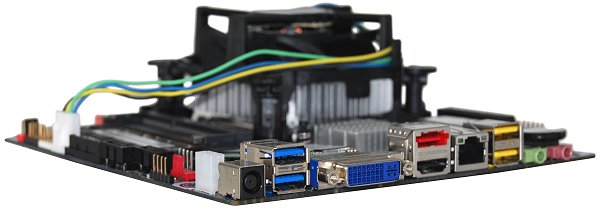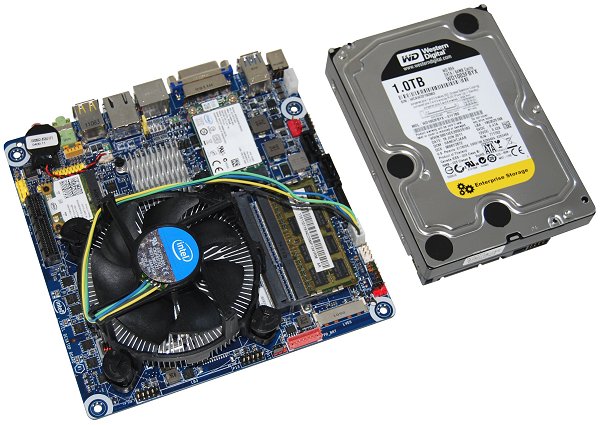Design & Layout
With so many onboard headers, the Intel DH61AG's landscape is fairly unkempt-looking, but everything pieces together well enough and we couldn't spot any major design flaws. Unfortunately, we couldn't showcase the DH61AG in a suitable Thin Mini-ITX chassis as Intel didn't provide one, nor was the appropriate cooler included.

The standard LGA1155 box cooler measures 45mm tall, which is far too big for use in a thin chassis, though it can be installed on the DH61AG without any problems. There are aftermarket coolers such as the Gelid Slim Silence i-Plus which are much more compact, this particular example is just 28cm tall.
It is important to make sure an aftermarket heatsink will suit the DH61AG before making the purchase, as the CPU socket area is extremely busy. There is a pair of USB 2.0 headers that encroach on the CPU heatsink's territory and we suspect that many aftermarket coolers will block access to these headers.
Directly above the CPU socket are two SO-DIMM slots that are relatively easy to access. We populated them with a pair of G.Skill 4GB DDR3-1333 modules that ran just $40.

Immediately to the left of the SO-DIMMs is a full size mini-PCI Express connector which received a $200 Intel 310 Series 80GB mSATA (SSDMAEMC080G2) card – a solid boot drive.

There is also a half size mini-PCI Express connector for optional wireless network support – the $20 Intel WiFi Link 1000 (112BNHMW), in our case.

In the top left hand corner of the board is an internal 19v DC input that allows the DH61AG to take advantage of internal power connectors. There are also two vertically mounted SATA connectors along with a SATA power connector capable of feeding two devices.

Further across the board we have the LVDS/eDP connector designed for uSFF HTPC and AIO systems. Complementing this connector is a series of jumpers that allow display voltage selection, backlight inverter voltage control and display brightness control.
Along with the standard front panel header for the power/reset buttons as well as the hard drive and system activity LEDs, a second header targets home theater users. Known as the HTPC header, it includes a recording LED, HDMI CEC access and more. The consumer IR (CIR) header is also HTPC-orientated and supports an internal Microsoft eHome IR receiver.

Finally the 1" (25mm) tall I/O panel features an external 19v DC plug, dual link DVI port, HDMI-out, eSATA, two USB 2.0 ports, two USB 3.0 ports, gigabit Ethernet and two audio jacks.
